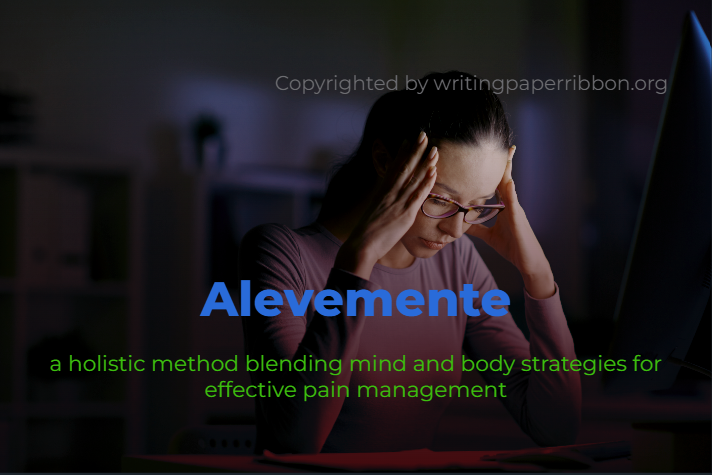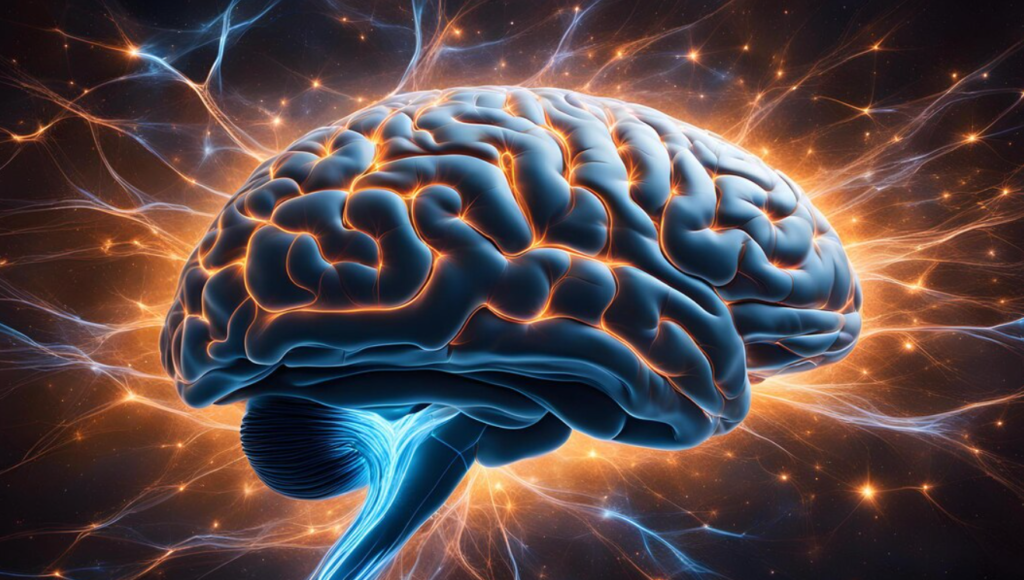Alevemente: Explore a New Way to Manage Pain Holistically
Introduction
Alevemente, a term blending “aleve,” a common pain relief medication, and “mente,” the Spanish word for “mind,” embodies a holistic approach to pain management. It acknowledges the intricate relationship between physical discomfort and mental well-being, offering a comprehensive strategy that integrates both aspects into treatment.

Table of Contents
Importance of Alevemente in Modern Medicine
In contemporary medical practice, Alevemente holds significant importance due to its recognition of the interconnectedness between physical pain and mental health. Traditional approaches to pain management often prioritize alleviating physical symptoms while overlooking the psychological distress that accompanies chronic pain. Alevemente fills this gap by addressing both dimensions, thereby offering a more balanced and effective method of pain relief.
Historical Background
The roots of pain management extend deep into human history, with ancient civilizations employing various remedies and interventions to alleviate discomfort. Practices such as herbal medicine, acupuncture, and surgical procedures were prevalent across cultures and time periods. For instance, ancient Egyptians used willow bark, containing salicin, a precursor to aspirin, for pain relief. These early approaches laid the groundwork for the development of modern pain management strategies.
Evolution of the Alevemente Concept
The concept of Alevemente has evolved over time, drawing inspiration from ancient holistic practices that emphasized the connection between mind and body. Systems like Ayurveda and Traditional Chinese Medicine recognized the importance of achieving harmony between physical and mental health. In the modern era, scientific advancements and a deeper understanding of psychology have further shaped the Alevemente approach, emphasizing the need for a comprehensive understanding of pain and its treatment.
Scientific Foundations

Pain perception is a complex process involving intricate neurobiological mechanisms. When the body encounters a painful stimulus, nerve fibers transmit signals to the spinal cord and brain, where they are processed and interpreted. Key brain regions involved in pain perception include the thalamus, somatosensory cortex, and limbic system. Chronic pain can lead to alterations in these neural pathways, resulting in heightened pain sensitivity and emotional distress.
Psychological Aspects of Pain

Beyond its physical manifestation, pain also has significant psychological dimensions. Emotional factors such as stress, anxiety, and depression can exacerbate the perception of pain, leading to a cycle of increased suffering. Psychological therapies, such as cognitive-behavioral therapy (CBT) and mindfulness-based stress reduction (MBSR), aim to break this cycle by helping individuals develop healthier coping mechanisms and change their perception of pain.
Integration of Mind and Body in Pain Perception
The integration of mind and body is central to the Alevemente approach. Research has shown that psychological interventions, such as mindfulness meditation and CBT, can profoundly influence pain perception. These techniques help individuals focus on the present moment, reduce stress, and develop a more positive outlook, all of which contribute to pain relief. Physical therapies, such as exercise and physiotherapy, also play a crucial role in pain management by strengthening muscles, improving flexibility, and reducing inflammation.
Alevemente Techniques

Mindfulness and meditation are core components of the Alevemente approach. Mindfulness involves paying attention to the present moment without judgment, fostering awareness of one’s thoughts and feelings about pain. Meditation practices help individuals achieve a state of calm and clarity, promoting relaxation and reducing the emotional impact of pain. These techniques can be practiced in various forms, including guided meditation, mindful breathing exercises, and body scans.
Cognitive-Behavioral Therapy
Cognitive-behavioral therapy (CBT) is a widely used psychological treatment for chronic pain. CBT helps individuals identify and challenge negative thought patterns and behaviors that contribute to their pain experience. By promoting more adaptive coping strategies and altering maladaptive beliefs about pain, CBT can lead to significant reductions in pain intensity and improvements in overall quality of life.
Physical Therapy and Exercise
Physical therapy and exercise play integral roles in the Alevemente approach to pain management. Physical therapists design personalized exercise programs tailored to individuals’ specific pain conditions and physical abilities. These programs typically include exercises aimed at strengthening muscles, improving flexibility, and enhancing cardiovascular fitness. Regular physical activity not only helps reduce pain but also improves physical function and promotes overall well-being.
Pharmacological Interventions

Pharmacological interventions, such as medication, are often a necessary component of pain management, particularly for acute or severe pain. Nonsteroidal anti-inflammatory drugs (NSAIDs), such as ibuprofen and naproxen (e.g., Aleve), are commonly used to reduce inflammation and alleviate pain. Other medications, such as opioids, muscle relaxants, and antidepressants, may also be prescribed depending on the nature and severity of the pain. It is essential for healthcare providers to carefully consider the benefits and risks of pharmacological interventions and monitor patients for potential side effects.
Nutritional Approaches
Nutrition plays a vital role in managing pain and inflammation. A diet rich in anti-inflammatory foods, such as fruits, vegetables, whole grains, and omega-3 fatty acids, can help reduce chronic pain and improve overall health. Certain nutrients, including vitamin D, magnesium, and antioxidants, have been shown to support pain relief and reduce inflammation. The Alevemente approach includes nutritional counseling to help individuals adopt dietary habits that support pain management and promote well-being.
Acupuncture and Alternative Therapies
Acupuncture, an ancient Chinese therapy, has been used for centuries to alleviate pain and promote healing. By inserting thin needles into specific points on the body, acupuncture stimulates the release of endorphins, the body’s natural pain-relieving chemicals, and modulates the nervous system’s response to pain. Other alternative therapies, such as chiropractic care, massage therapy, and yoga, can also complement the Alevemente approach by providing additional avenues for pain relief and stress reduction.
Lifestyle Modifications
Lifestyle modifications are essential components of the Alevemente approach to pain management. Factors such as sleep, stress management, and social support can significantly influence pain perception and overall well-being. Establishing healthy sleep habits, practicing stress-reduction techniques (e.g., deep breathing, progressive muscle relaxation), and nurturing supportive social relationships can all contribute to improved pain management outcomes.
Case Studies

Real-life case studies provide compelling evidence of the effectiveness of the Alevemente approach in managing chronic pain. These stories illustrate how individuals have achieved significant improvements in pain levels, mood, and overall quality of life through interventions such as mindfulness meditation, CBT, physical therapy, and lifestyle modifications. By addressing both the physical and psychological aspects of pain, the Alevemente approach offers a comprehensive and personalized strategy for pain management.
Future Directions
The field of pain management is continuously evolving, with ongoing research and innovations paving the way for new and improved treatment modalities. Emerging technologies, such as advanced neuroimaging techniques and virtual reality (VR) therapy, offer exciting possibilities for enhancing pain assessment and intervention. Policy changes aimed at improving access to integrative and complementary therapies, along with increased public awareness and education, are essential for advancing the Alevemente approach and ensuring that individuals living with chronic pain receive comprehensive and compassionate care.
Conclusion
In conclusion, 𝖺𝗅𝖾𝗏𝖾𝗆𝖾𝗇𝗍𝖾 offers a multifaceted approach to pain management that recognizes the interconnectedness of physical and mental health. By addressing both dimensions of pain, 𝖺𝗅𝖾𝗏𝖾𝗆𝖾𝗇𝗍𝖾 provides individuals with comprehensive tools to manage their symptoms and improve their overall well-being. As we continue to advance our understanding of pain and its treatment, 𝖺𝗅𝖾𝗏𝖾𝗆𝖾𝗇𝗍𝖾 stands as a beacon of hope for those seeking relief from chronic pain.
FAQs
What is Alevemente?
Alevemente is a holistic approach to pain management that integrates both physical and mental health aspects. It combines various techniques, including mindfulness, cognitive-behavioral therapy (CBT), physical therapy, and nutritional approaches, to address pain comprehensively.
How does Alevemente differ from traditional pain management?
Unlike traditional pain management, which often focuses solely on alleviating physical symptoms, Alevemente recognizes the interconnectedness of physical pain and mental well-being. It emphasizes the importance of addressing psychological factors such as stress, anxiety, and depression in addition to physical discomfort.
What are the key components of the Alevemente approach?
The key components of Alevemente include mindfulness and meditation, cognitive-behavioral therapy (CBT), physical therapy and exercise, pharmacological interventions, nutritional approaches, acupuncture and alternative therapies, and lifestyle modifications. These techniques work synergistically to provide holistic pain relief.
Who can benefit from Alevemente?
Alevemente can benefit individuals living with various types of pain, including chronic pain conditions such as fibromyalgia, arthritis, and back pain. It is suitable for people of all ages and backgrounds who are seeking a comprehensive and personalized approach to pain management.
Are there any side effects associated with Alevemente?
Alevemente techniques are generally safe when practiced under the guidance of trained healthcare professionals. However, as with any medical intervention, there may be potential side effects or contraindications depending on the specific therapy being used. It’s essential to discuss any concerns with your healthcare provider before starting Alevemente treatments.
How long does it take to see results with Alevemente?
The timeline for experiencing results with Alevemente varies depending on individual factors such as the type and severity of pain, adherence to treatment protocols, and overall health status. Some individuals may notice improvements relatively quickly, while others may require more time and ongoing therapy to achieve optimal outcomes.
Is Alevemente covered by insurance?
Insurance coverage for Alevemente techniques may vary depending on the specific therapy and individual insurance plans. While some aspects of Alevemente, such as traditional medical treatments and therapy sessions, may be covered by insurance, others, such as acupuncture or nutritional counseling, may not be covered. It’s essential to check with your insurance provider to understand your coverage options.
Can I practice Alevemente techniques at home?
Many Alevemente techniques can be practiced at home, including mindfulness meditation, relaxation exercises, and gentle physical activities. However, it’s essential to receive proper instruction and guidance from healthcare professionals, especially for more complex therapies such as CBT or acupuncture. Additionally, maintaining open communication with your healthcare team is crucial for monitoring progress and adjusting treatments as needed.
Where can I learn more about Alevemente?
You can learn more about Alevemente by consulting with healthcare professionals specializing in pain management, accessing reputable online resources, and participating in support groups or educational programs focused on holistic health and wellness. Additionally, books, articles, and research studies on pain management and integrative medicine can provide valuable insights into the Alevemente approach.
Is Alevemente suitable for everyone?
While Alevemente can benefit many individuals living with chronic pain, it may not be suitable for everyone. Factors such as individual health conditions, treatment preferences, and accessibility to resources may influence the suitability of Alevemente for certain individuals. It’s essential to consult with healthcare professionals to determine the most appropriate pain management approach for your unique needs and circumstances.
If you found our content helpful don’t forget to share it on your social media: Twitter
More Articles: Home






One Comment